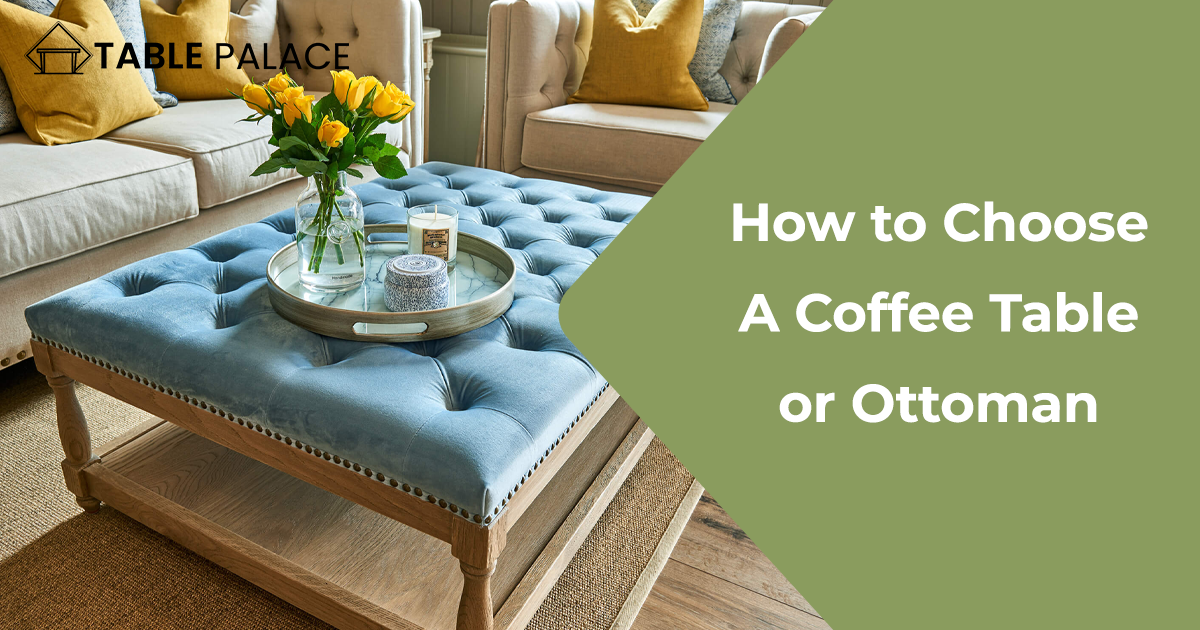In this comprehensive guide on how to choose a coffee table or ottoman, we’re going to explore the nuances of selecting the ideal coffee table or ottoman for your living room. At first glance, this may appear to be a simple choice, but anyone who has ever misjudged this decision understands the complexity hidden beneath the surface. Often, we invest considerable time and effort in choosing sofas and rugs, relegating coffee tables and ottomans to a secondary status.
However, it’s crucial to recognize that these pieces are among the most utilized and functional in our living spaces, and deserving of thoughtful consideration. I aim to guide you through several critical considerations, ensuring you have a clear understanding of what to look for when making your purchase. With this knowledge, you can narrow down your options and approach your decision with confidence, increasing the likelihood of making the right choice on your first attempt.
To facilitate this process, let’s ponder over these five essential questions:
- Do you require a coffee table or an ottoman, or perhaps both?
- Is storage a necessary feature for your chosen piece?
- What dimensions would be most suitable for your space?
- Which shape would best complement your living room’s layout and aesthetic?
- What style resonates with your personal taste and home decor?
By answering these questions, you’ll be well-prepared to embark on your quest for the perfect coffee table or ottoman that will enhance the functionality and style of your living room. So, without further ado, let’s delve into these considerations and begin our journey toward finding your ideal living room centerpiece.
Do you want/need a coffee table or an ottoman?
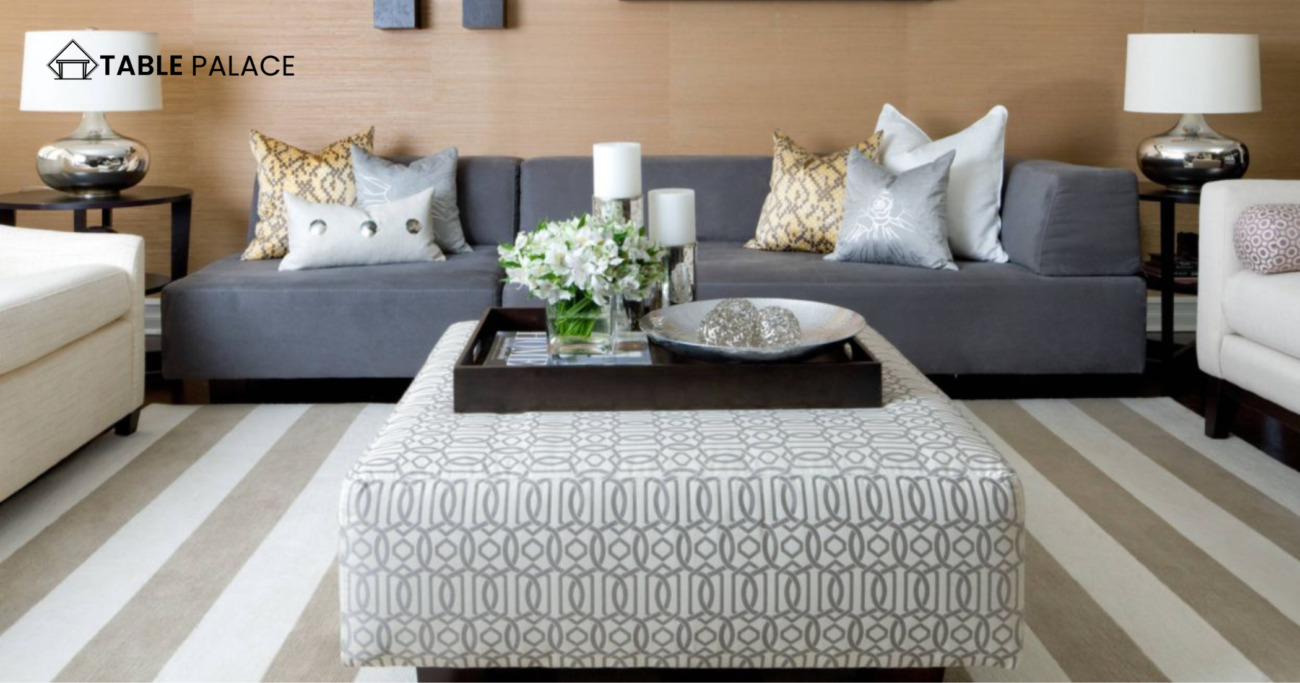
Addressing this question is an excellent starting point, as it immediately streamlines your search. If you find yourself daunted by the plethora of options available, deciding between an ottoman and a coffee table right from the beginning can significantly simplify the process.
This choice is influenced by both personal taste and practical considerations. It’s crucial to reflect on your specific needs and how you intend to utilize this furniture piece.
For instance, are you looking for a piece primarily to serve as a table, or do you prefer something that offers a comfortable spot for resting your feet? If you have children, is it important for the furniture to have soft edges for safety? Consider the activities that usually take place in this space. Do you require a sturdy surface for activities like playing board games, or for placing food and beverages?
If this space is primarily used for watching TV, perhaps creating a relaxing and comfortable environment is your main objective.
Furthermore, it’s important to consider the broader context of how you use your living room or family room. Think about your current or planned seating arrangement and other existing or potential pieces of furniture, such as side tables, that contribute to the room’s functionality. Adopting a more holistic perspective allows you to ensure that all elements in the room work cohesively, not only enhancing the room’s aesthetic appeal but also its practicality and comfort. By taking into account these broader aspects of your living space, you can make a more informed decision that aligns with both your lifestyle and design preferences.
Do you want/need it to provide storage?
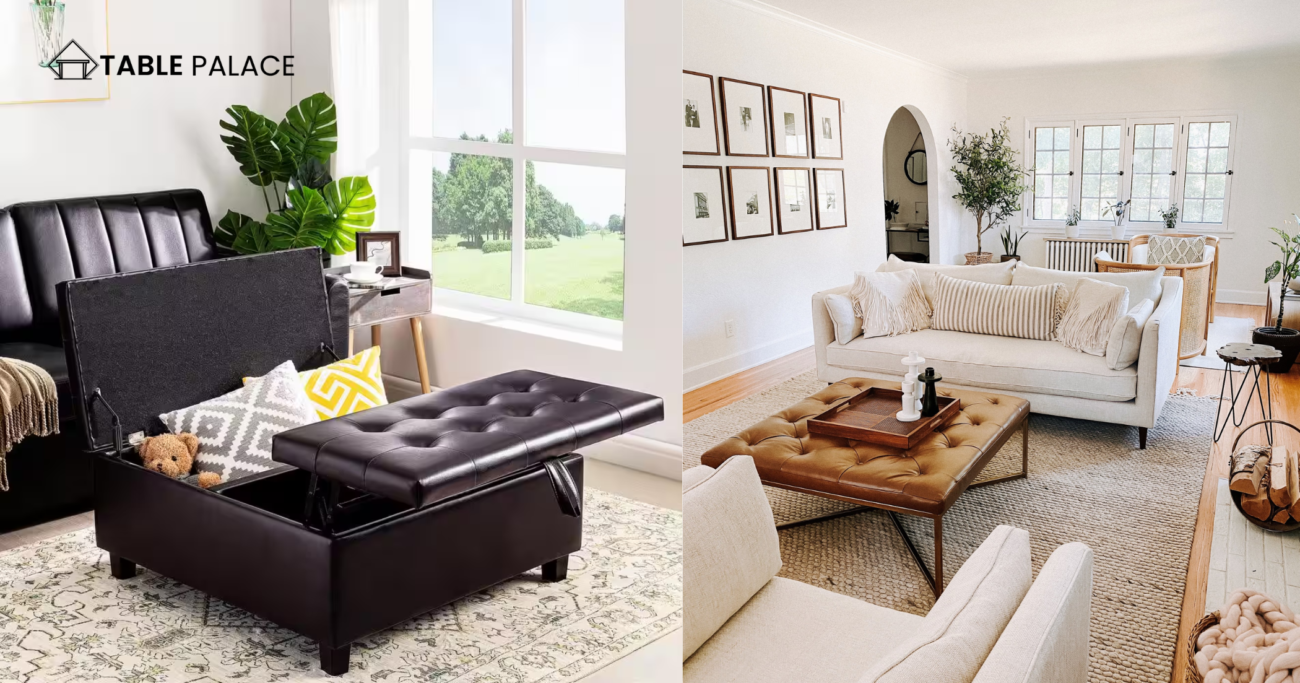
If you determine that storage is a requirement for your coffee table or ottoman, the next logical step is to identify what items you need to store. The market offers a variety of coffee tables and ottomans equipped with storage capabilities, but it’s essential to have a clear idea of what you intend to store in them to ensure the chosen piece meets your specific needs.
Are you looking to store children’s toys, blankets, or remote controls? It’s important to verify the dimensions of the storage compartment to ensure it is adequately sized and shaped for your items. If these dimensions are not readily available, don’t hesitate to contact the retailer for more information.
It’s worth noting that some pieces labeled as “storage” ottomans or coffee tables may offer only limited space, which might not be sufficient for your needs, so it’s beneficial to gather this information beforehand.
Another aspect to consider regarding storage is the possibility of pairing your table or ottoman with baskets or bins. In some cases, an open coffee table that accommodates one or two baskets underneath might provide the perfect amount of storage. This approach also offers flexibility, allowing the storage solution to adapt to your changing needs over time.
By exploring these options, you can find a balance between functionality and aesthetics, ensuring that your new coffee table or ottoman not only enhances the look of your space but also serves its intended practical purpose effectively.
What size works best?
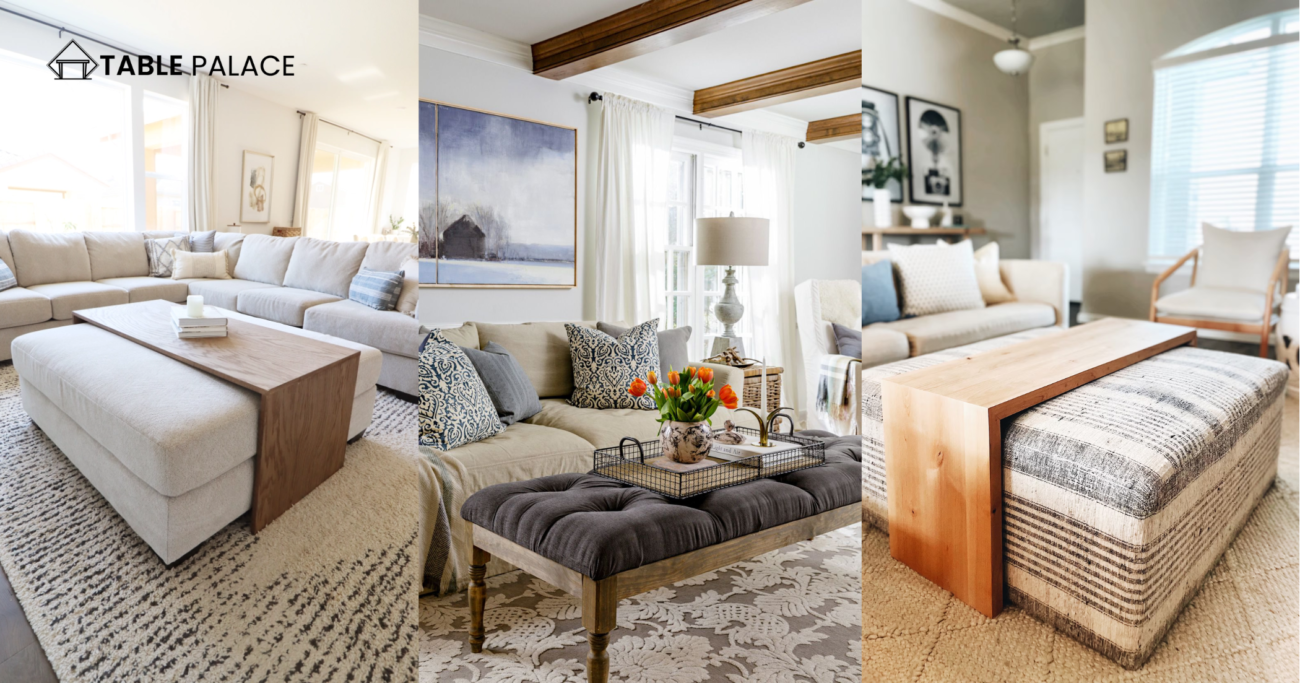
Selecting the correct size for your coffee table or ottoman is crucial, and it’s a decision where many often go astray. A common error is choosing a piece based solely on its style, without adequately considering its dimensions and how it will integrate with the existing furniture in the room.
The realization that the piece is too large, too small, too short, or too tall often comes only after it has been placed in the living room. To prevent this mistake, let’s focus on some general guidelines for choosing the right size for your coffee table:
- Length: Aim for a coffee table that is approximately one-half to two-thirds the length of your sofa. To calculate this, multiply the length of your sofa by 0.5 or 0.66. If you have a sectional or a sofa with a chaise, apply this calculation to the length of the seating area, not the overall length. This guideline is applicable regardless of the table’s shape.
- Height: The ideal height for a coffee table is roughly the same as the height of your sofa cushions, give or take a couple of inches. I recommend choosing a table that is 1-2 inches lower than the seat cushions of your sofa. If you plan to rest your feet on it, a slightly lower height than your seat cushions is preferable for comfort. Conversely, a table that is taller than your seat cushions can be uncomfortable for your legs.
- Placement: Maintain a distance of about 12-18 inches between your coffee table or ottoman and the surrounding furniture. This spacing ensures sufficient room to move around and allows for easy access to items on the table. Ideally, the table should be accessible from multiple seating positions in the room, such as from both the sofa and chairs.
In general, the goal is to select a coffee table or ottoman that is both functional and proportionate to the other furniture pieces and the overall room. Scale is a key factor to consider. In larger living rooms or with oversized sofas, you might want to consider using two matching ottomans or coffee tables.
This approach can effectively fill the space, making the surfaces more accessible to more people, and often proves to be more budget-friendly than opting for a single, larger piece.
What shape works best?
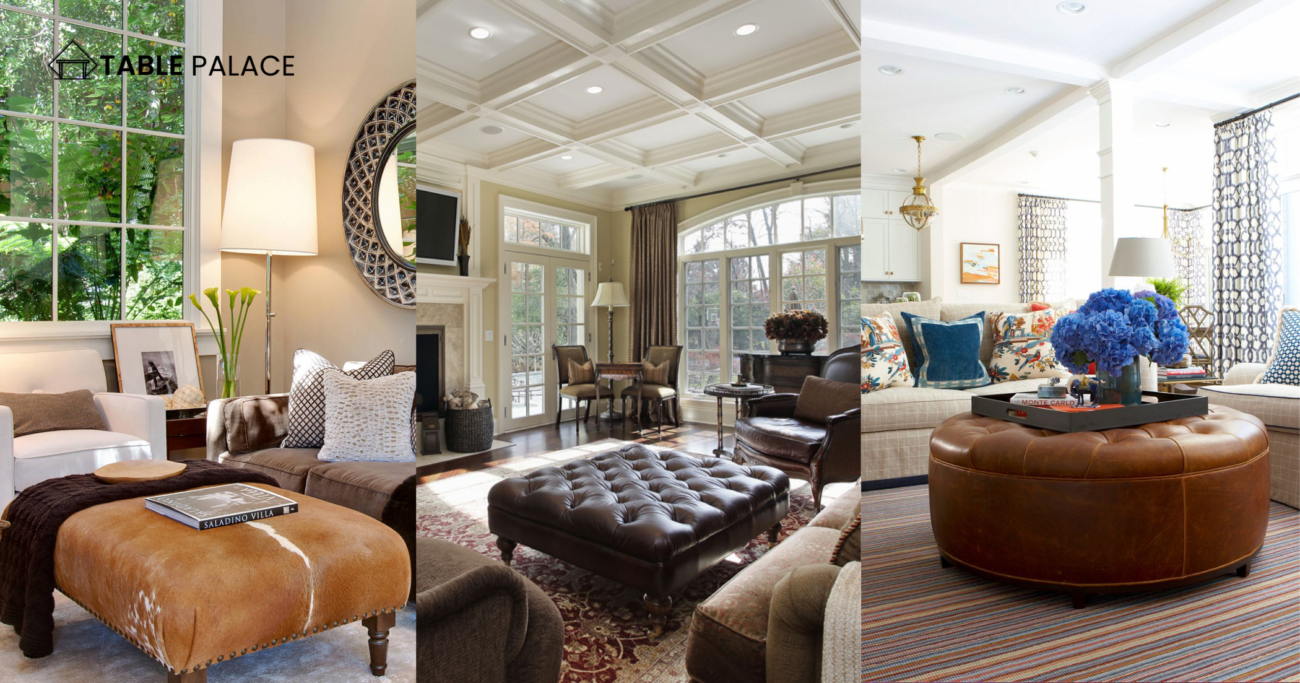
Choosing the shape of your coffee table or ottoman – be it square, rectangle, round, or oval – is a decision influenced by both design aesthetics and practical considerations. From a design standpoint, it’s beneficial to consider the existing pieces in your room to achieve a harmonious balance of shapes. This balance plays a crucial role in creating a space that feels both welcoming and well-structured.
A room with too many sharp angles can appear cold and rigid, whereas an excess of rounded edges may result in a lack of necessary structure. Therefore, if your room already contains a number of square or rectangular elements, opting for a round or oval coffee table or ottoman could provide a pleasing contrast. Conversely, if your space predominantly features curved lines and shapes, a rectangular or square piece might be more appropriate.
On the practical side, consider the flow of movement within the room. This is particularly important in smaller living spaces, where ease of movement and accessibility are key. In such scenarios, a round table might facilitate smoother navigation around the room compared to a rectangle or square, which can present more angular obstacles.
The goal is to select a shape that not only complements the design of your room but also enhances its functionality, ensuring that movement within the space is intuitive and unobstructed. By carefully considering both these aspects – the aesthetic balance and the practical flow – you can choose a coffee table or ottoman shape that beautifully integrates into your living space, contributing both to its style and its livability.
What’s your style?
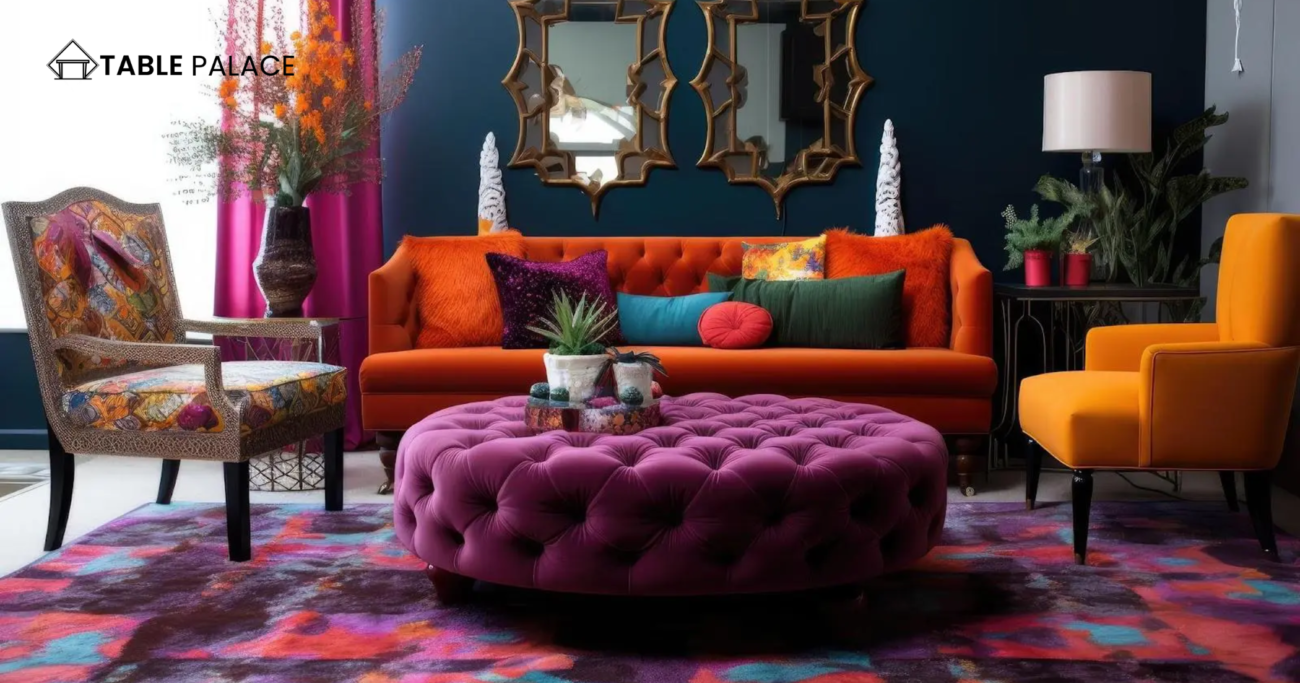
I’ve intentionally positioned the consideration of style as the final question in this selection process. While style is undoubtedly a significant factor in choosing a coffee table or ottoman, it’s crucial to address all the practical aspects first. Rest assured, you will find a piece that aligns with your style preferences.
However, it’s essential to avoid the common pitfall of falling for a piece that perfectly matches your style but fails to meet your size, shape, or functional requirements. There’s a certain disappointment that comes with realizing, “It’s so beautiful, but it just doesn’t suit our living needs.” This sentiment is all too familiar and can be avoided by prioritizing practicality before style.
By making your style choice the last step in your decision-making process, you ensure that the piece you select is not only aesthetically pleasing but also fits seamlessly into your living space in terms of size, shape, and functionality.
This approach leads to greater long-term satisfaction with your choice, as the coffee table or ottoman you choose will not only look great but will also cater to the specific needs of your lifestyle and the dynamics of your living area. Remember, the right piece is one that beautifully complements your style while also enhancing the practicality and comfort of your living space.
Conclusion
In summary, choosing the right coffee table or ottoman involves balancing practical needs with aesthetic preferences. Consider the purpose (whether for storage or comfort), size (proportional to your sofa and room), shape (complementing existing furniture and allowing easy movement), and finally, style. By prioritizing functionality and then style, you’ll select a piece that not only looks great but also seamlessly fits into your living space, enhancing both its appearance and usability.

